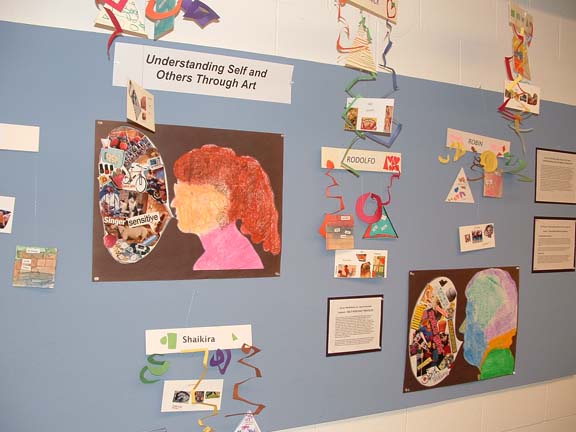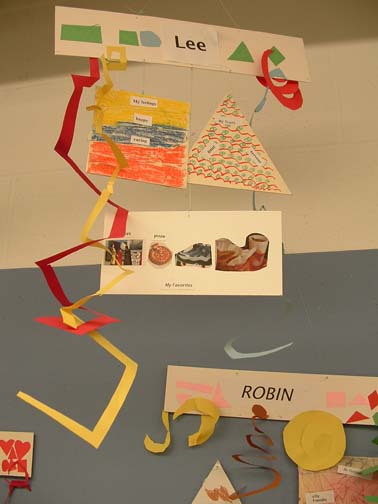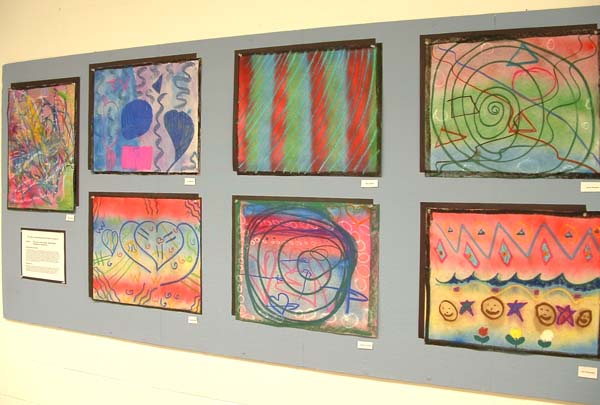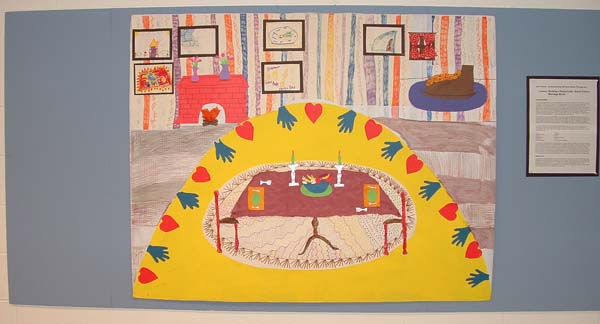Unit Theme: Understanding Self and Others Through Art
Author: Lucy Andrus

To address the social development of our teens in special education, the theme of this unit centered on increasing self-awareness, learning more about the people around us, and understanding what it takes to build positive relationships. The students explored these concepts through art experiences, learning how various artists have addressed such issues in their work, and applying their own art skill and knowledge in expressing a personal response to each idea presented. We began with a focus on the self, as the students came to realize that knowing about oneself is a prerequisite to communicating and getting along well with others. Concepts of line, color, shape and texture were used to express ideas and feelings as students developed their understanding of symbolic representation in art.
Exploration of the self was followed by lessons focusing on peer interaction and communication, and finally, on the development of a loving relationship between two people. Based on the students’ expressed desires to learn more about committed love, this culminating project centered on what it takes to build a successful marriage relationship, and how artmakers have expressed ideas about this human connection in their work. In their Scene From a Marriage mural, the students have depicted an interior scene from a marriage, sharing their view of what it takes to successfully build such a relationship both in the literal as well as abstract sense.
2. Mixed Media Self-Portrait Mobiles
4. The Color of My Dreams, Mixed Media Paintings on Interfacing
Spring 1999 McKinley H.S. Special Education
Lesson 1: Self Portrait Profiles

Conceptual Basis of the Lesson
For the students in the Community-Based Special Education program at McKinley, increasing self-awareness and building self-esteem through accomplishment are vital aspects of their life skills curriculum. Art experiences that explore the self help to enrich this process. To begin, the students spent time viewing and discussing the portrait work of several artists including Frida Kahlo, Vincent Van Gogh, Jacob Lawrence, Chuck Close, Elizabeth Layton, Mary Cassatt, Auguste Renior and William Johnson. The students realized that they could tell many things about a person just by examining their portraits. We also learned how an artist could tell us about the subject of a portrait through such things as a gesture, a facial expression, posture, or a gesture. Awareness, understanding and self-expression through non-verbal communication are an important educational and therapeutic learning area for the students.
To create their self-portraits, the students' actual profiles were traced on paper and personal colors were added along with magazine words and images that represent the person. The viewer is invited to examine these portraits of the Art Partners and see what information they reveal about their subjects.
Lesson 2: Mixed Media Self-Portrait Mobiles

Conceptual Basis of the Lesson
This initial lesson of our unit involved the students in self-exploration, with a focus on discovering more about who they are as people, deepening their sense of what “makes them tick” and what makes them unique as individuals. They learned how artists across time and cultures have explored such issues and ideas through various forms of portraiture. Based on these understandings, the students used a mobile form to create a kind of self-portrait that incorporates three aspects: My Favorites, My Traits, and My Feelings.
In the process, the students were able to apply their growing knowledge of art elements and principles and gain more experience and competence with mixing media. They were able to recall the use of symbolism through color, and learned to combine text with imagery to convey meaning.
Relation to Life
Self-awareness and developing a self-identity are typical developmental concerns of adolescents as well as prerequisites to understanding and building positive relationships with others. As the students move closer to adulthood and increasing independence, it is critical for them to develop their emotional intelligence and socialization skills in order to be successful out in the community. Exploring such concerns through art experience helps to develop creative problem-solving skills as well as equip young people with a useful tool for continued self-expression beyond their school years.
Lesson 3: Moods, Emotions and Me

Conceptual Basis of the Lesson
This second lesson in our unit focused on self-awareness and understanding of emotions and moods, and how color is used to reflect emotion in visual imagery. The students explored the various emotions and moods any one individual can experience at any given time (we are complex creatures!) while learning how artists express such ideas through the symbolic use of color.
Using multiple black and white Xerox copies of photographic self-portraits, the students used oil pastels to add color in ways that express contrasting moods or emotions. In studying Andy Warhol’s multiple portraits series, the students gained a better understanding of the emotional effects achieved by his use of different color backgrounds, and how these convey meaning about their subjects.
Relation to Life
An underlying purpose of this lesson was to cultivate emotional intelligence with the aim of helping the students to learn to manage their feelings effectively. These young men and women area at a stage where development of self-identities and curiosity about relationships is peaking. Increasing awareness about one’s emotional self helps provide a foundation for understanding others as we work towards learning how to build healthy and positive relationships.
Lesson 4: The Color of My Dreams, Mixed Media Paintings on Interfacing

Conceptual Basis of the Lesson
This was the third lesson in our unit on understanding self and others through art. Previous lessons used art to address self-awareness in terms of personality traits, personal preferences, and emotions. To enhance self-concept development, this lesson engaged students in an exploration of their dreams and hopes for the future as they near the end of high school. Viewing the work of artists who have given form to their dreams through visual imagery, helped to enhance the students’ understanding of how art elements, particularly color, can be used to convey meaning and express ideas. The use of fluid painting media helped to enrich the students’ abilities for spontaneous self-expression and communication. In this case, the students were introduced to a non-traditional art material -- interfacing used in sewing-- helping to enhance creative thinking by experiencing the idea that materials for artistic self-expression can be found in our everyday surroundings.
Relation to Life
Opportunities for spontaneous self-expression are important for all adolescents, as is the development of their creative responses as they begin to make the transition to adulthood and finding their place in the larger world. Exploring goals, hopes and dreams should be a part of this process. In addition, experimenting with a mixed-media, multi-step art process allows students the chance to practice important skills needed in the workplace such as planning, sequence, and follow-through.
Lesson 5: Building a Relationship: Scene From a Marriage Mural

Conceptual Basis of the Lesson
For our final project of the unit on Understanding Self and Others Through Art, we moved from a focus on the self, toward a focus on others and how people establish, build and maintain relationships. The students had previously stated their curiosity and interest in learning more about love and other relationship concerns typical of young men and women, so we decided to pay particular attention to the relationship of marriage, and how artists have expressed ideas about this aspect of life. For the first lesson in this project, we began by viewing and discussing a slide presentation of marriage customs and traditions from around the world. The students were amazed by some very unique customs, and surprised that others were similar to some practiced here in the USA. This was also an opportunity to make cross-cultural connections, and develop appreciation for diversity.
The students then viewed and discussed works by artist, Marc Chagall, that specifically address his loving relationship with his wife, as well as images that depict everyday scenes from a marriage such as home life, work and raising children. The students were able to identify how Chagall’s use of color and shape helped to convey the warmth and unity of the marriage relationship. They also understood Chagall’s’ use of symbols to express ideas that were important to his life and his marriage relationship.
In order to create their own artwork about the marriage relationship, the students then spent time discussing and listing what they thought it takes to build a marriage, both in the concrete sense (necessities of daily life) as well as the abstract (qualities and characteristics of such a union). Here is their recorded list:
| Love | A Home |
| Caring, Sharing | Furniture |
| Respect | Food |
| Responsibility | Room for Children |
| Kindness | A Job |
| Working together | Fun things to do together |
From their list, the students then discussed ways to visually depict these ideas, from the use of symbols such as heart and hands to show togetherness, and planting of a garden to show the need for couples to work and make things grow together, to the use of light and warm colors in the fireplace, candles, and in the arc of light surrounding the table scene to show feelings of love and caring. In order to complete each component of their ‘scene from a marriage’, which includes visual references to both the concrete and the abstract; the students had to practice socialization skills of cooperation and working together for the common good. The student also included miniature works of art in their marriage scene to remind us of the importance of enriching our experience by incorporating the aesthetic into our everyday lives.
Relation to Life
Their teachers expend great time and effort in the students’ living skills curriculum on fostering as much independence as possible while educating them for successful living and working in the community after graduation. This group art experience addressed the students’ need to learn more about adult intimate relationships, what they require, how to maintain them, and the responsibilities involved. Such knowledge will help empower the students to care for themselves, make good choices, and learn what it takes to care for another in a positive and productive way.
This is a non-commercial website and is to be used for educational or research purposes only. No commercial use is permitted without the consent of Art Partners. "Fair use" is claimed under U.S. copyright law, sections 107 and 108. For questions contact:Art Partners
©2002 Art Partners Program | All Rights Reserved